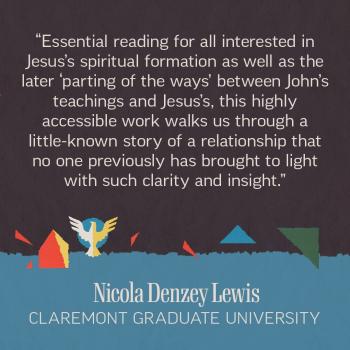I’m grateful to Bloomsbury to have been given the opportunity to review the book Jesus and Brian: Exploring the Historical Jesus and his Times via Monty Python’s Life of Brian
, which was just released.
Not everyone is aware that the famous Monty Python film reflects not just sharp British wit, but also profound understanding of the ancient context in which Jesus lived. A recent conference focused in on this, and this volume publishes the papers from that conference, which took place at King’s College, University of London. After a foreword about reception history as an approach to Biblical studies, Joan Taylor introduces the volume, telling the story of how it came about, and included members of Monty Python among the speakers. Taylor also highlights how reception history has gone from being an approach that looks almost exclusively at what is done with the text, to an approach that raises new questions to ask in the study of the text itself (pp.xxvi-xxvii).
Chapter 1 by William Telford places Life of Brian within the context of the broader genre of Jesus films. His survey confirms the conclusion drawn more than a decade earlier by pioneering Pythologist Philip Davies, namely that the film had been meticulously researched and showed profound awareness of both biblical scholarship and the history of film related to this subject matter. Telford also highlights the things that distinguish Life of Brian from most Jesus films, and the debates among scholars about whether the movie should be considered a Jesus movie, and its central figure a Christ figure, or not.
In chapter 2, Richard Burridge looks at the reactions to and criticisms of the film on the part of churches and other religious bodies. In the process of recounting a key event, Burridge notes the relevance to historical Jesus studies of the overall agreement in recollection, combined with disagreement about where the incident occurred, among those involved (pp.30-31). We also learn about a deleted scene from the film which provides the background to a puzzling scene near the end. The chapter concludes with reflections on whether the movie could have been made today, and whether the church missed an opportunity to engage in more serious reflection about the film when it was released. Chapter 3 by David Shepherd then focuses on the relationship of Life of Brian to other Biblical parody films, with particular attention to Wholly Moses!.
In chapter 4, David Tollerton takes as his starting point the film’s own parody of ancient blasphemy laws – foreseeing and lampooning in advance those who would claim the movie itself was blasphemous. This leads to a survey of blasphemy legislation more generally, in Jesus’ time, in 1970s Britain, and today. In chapter 5, James Crossley takes a close look at the depiction of Jesus in Life of Brian. His comparison of Brian’s emphatic assertions of his own Jewishness in the movie, and scholars’ insistence about Jesus’ Jewishness, is insightful and thought-provoking. So too is his suggestion that scholarship itself is at times deserving of comic parody.
Philip Davies (mentioned earlier) focuses on “The Gospel of Brian” in chapter 6, drawing near the beginning on psychological studies of the effect of religiosity on the production and appreciation of humor, and echoing Crossley’s point that scholarship itself sometimes deserves to be mocked. Davies then revisits his own earlier scholarship on the film and seeks to improve on his earlier conclusions and observations. Catching himself accepting without question details from tradition about which a historian ought to have doubts, he uses the film to raise similar questions about what if anything we can know about the historical Jesus, critiquing in the process the penchant of historians to take what may be theological details in our sources and to seek to convert them into historical facts (p.87). Davies concludes by observing the difference between Brian the ordinary man and Brian the Messiah, and how this relates to the third figure who is mostly offstage, the recognizable Jesus who may relate more to the “Brian of the future” than the one we see onscreen.
Starting off the second part of the book, Joan Taylor is the author of chapter 7 which uses Life of Brian as a way to explore the method of reception exegesis itself. Taylor focuses in briefly, by way of illustration, on the alien spacecraft scene in the film, and considers how awareness or lack of awareness of the ideas of Erich von Däniken might impact the appreciation of this scene. Taylor observes how most Bible epics ignore Biblical scholarship, and suggests that the “perfect presentation of the Hollywood Christ” in Life of Brian “is itself a form of parody” (p.96). She then explores historical perspectives on the lives of ordinary people in the time of Jesus, and offers some thoughts on what might have happened if a historical Brian had met the historical Jesus.
In chapter 8, Guy Stiebel looks briefly at Roman and Jewish identities and interactions both in history and in the movie. In chapter 9, Helen Bond focuses in on crucifixion in history and the movie. Despite some protests that crucifixion is no laughing matter, gallows humor continues to this day, and Bond shows the same was true in ancient times with respect to crucifixion. The chapter also explores the way mockery has been used as a tool of oppressors and as a form of resistance by the oppressed, and the ways this is reflected in the movie as well as historical sources. Bond suggests that Life of Brian does scholars a service by failing to provide the crucifixion scene we expect, jolting us out of our penchant to deal with the crucifixion of Jesus in a manner that is docetic and ahistorical. The film also raises questions about what role Jesus played in fostering the view of him that his followers later had, particularly with respect to the interpretation of his death.
In chapter 10, George Brooke looks at Brian as a teacher of righteousness. The allusion to the Dead Sea Scrolls is intentional, and the focus in the chapter is on how Brian compares with and relates to another figure than Jesus from that time period. Brooke looks at connections between the film and the Dead Sea Scrolls, including an exhibit which addressed the question “What have the Romans ever done for us?” In chapter 11, Bart Ehrman looks at parody as a historical method. He begins with an autobiographical note about his experience of seeing the movie while himself a conservative Christian. He then goes on to highlight how the depiction of Brian as eyewitness to the life of Jesus raises serious issues about the Gospels as sources of knowledge about the historical Jesus. The chapter concludes with a discussion of a topic to which Ehrman has given much attention in recent years, namely the question of whether a crucified individual would have been given a decent burial in Jesus’ time.
In chapter 12, Paula Fredriksen looks at the way Paul and the Gospel authors turned to the Septuagint in order to produce their accounts of the life of Jesus. Using the corresponding elements in Life of Brian as a foil, Fredriksen addresses such historical questions as whether Jesus claimed to be the Messiah, and the implausibility of the infancy narratives. In looking at the apocalyptic context of Jesus, she notes that “What we think of as ‘Christianity’ succeeded precisely as its foundational prophecy failed” (p.165), and turning failure into success involved the creative use of Jewish Scripture to weave a new version of Jesus’ story.
In chapter 13, Amy-Jill Levine looks at gender and sexuality in the uncut version of the movie, noting that the film is not as willing to address matters of sexism and heteronormativity as it is willing to address matters of religion and politics. Absurd questions and other “laugh lines” in the Gospel of Matthew are also discussed. Questions are asked about whether the fact that Mrs. Cohen is Terry Jones in drag prevents the audience from noticing how independent a woman this character is, and how this contrasts with stereotypes about an ancient patriarchal era (p.171). The proposal that Jesus was a mamzer of uncertain or known illegitimate birth is mentioned, and Brian’s relationship to his mother as an adult is compared with what the Gospels depict. The relevance of other key female characters – including the women with beards – is discussed, as is Loretta and notions of gender fluidity both ancient and modern.
In chapter 14, Steve Mason considers anti-Roman sentiment in Josephus and Life of Brian. The chapter is focused mostly on ancient historical evidence, and challenges the viewpoint – assumed in the movie – that there was widespread hatred of Rome and the Romans among Jews. In the process he notes that the famous mention of the aqueduct in the movie is “a dead-on reference to Pilate’s aqueduct project” (p.205). In chapter 15, Adele Reinhartz looks at the Jewish identity of Brian and Jesus, also working in a mention of Joe the Canadian as she explores the comical use of stereotypes. In chapter 16, Katie Turner looks at costuming in the movie in relation to historical evidence, as well as from the perspective of film studies and the role that current stereotypes play in the depiction of the past. Turner suggests that “When a film about the life of Jesus claims historical accuracy, there is one simple litmust test that can be used: what does Pontius Pilate wear?” (p.236). She goes on to say, “If Monty Python can get this right, so should any other film of this period, especially those that ask audiences to take them seriously” (p.237). The book concludes with a substantial bibliography, indexes, and color plates of images.
Hopefully my inadequate overview here gives readers a taste of what the book contains, and at least a hint of the depth and richness, the seriousness and humor, of the discussions. If your interest is just in Monty Python or ancient history, the book will open up new avenues for bringing the past and present into conversation in interesting ways. And if you are, like me, someone who has a profound enjoyment of Monty Python and an interest in Jesus and his times which is both professional and personal, this is a book that you will not only benefit from reading, but which you will thoroughly enjoy. I highly recommend it.
Anthony Le Donne recently drew attention to the video from the conference which is on YouTube, featuring John Cleese and Terry Jones.
There are other videos from sessions at the conference online as well.













